
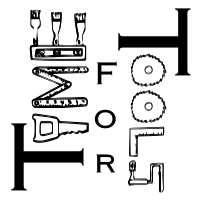

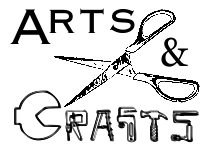


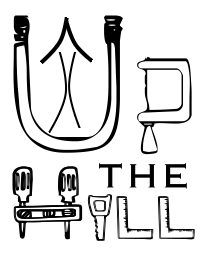



| Next Post - Previous Post List View
| |
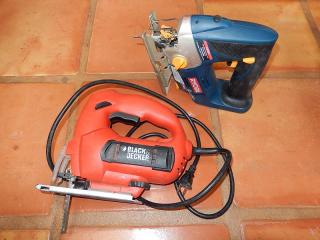 | 6/28/2014 12:15:30 PM Tool Review: Get Jiggy With It... Jigsaw Review and the Blue Ryobi One+ Jigsaw |
First, as with my Drill Review, I won't be giving advice on how to use a Jigsaw since you can google it for a few seconds and have a great selection of how-to, including this one from TheFamilyHandyman: How to use a jigsaw. So what I want to provide here is a little on the basics of why you need a jigsaw, and what to look for in a good jigsaw. I will also include a review of the Blue Ryobi One+ Jigsaw, and a few comparisons to the current green style. Click here to jump to the Ryobi review. What is a Jigsaw? A jigsaw is a hand-held power saw with a blade that extends out from the base at a right angle. This blade is propelled up and down by the saw and cuts into the wood as you slide the saw over the wood surface. This makes for adequate straight cuts like you would get with a hand-saw, but also can make nice curves, and even tight curves if you use the right blade. Blade selection means you can cut everything from tight curves in thin or soft wood to metal with a metal-cutting blade. The jigsaw's ability to cut curves is really what stands it apart from other hand-held power tools though. Why do I need a Jigsaw? The jigsaw is really the first power tool after a drill that I think someone should own. It's capability to cut multiple materials, straight and curves, and ease of handling make it ideal for everyone from a newbie to advanced hobby builder. And in fact, from the time I was 5 until I was 25, it was one of the only saws I used. I cut everything from thin wood to metal bolts to plastic barrels, and built everything from a wedge of scrap wood to industrial-strength furniture. Of course, I also beat up and burnt out a couple jigsaws doing it, too. Limitations... While I am very hard pressed to find anything that my jigsaws can't do (besides cutting through a 4x4), there are definitely areas where a different saw may do a better or easier job. First... cutting straight through 2x10 or bigger boards... trust me, a jigsaw will do it, but you will put a lot of strain on the saw and yourself in the process. For straight cuts through larger material, a circular saw would be faster and easier, though larger circular saws can be rightly intimidating to someone without a lot of upper-body strength. Cutting re-bar... despite the fact that I fully believe a jigsaw can handle even the toughest of re-bar, even the thickest metal-cutting blades for a jigsaw just don't seem to be made to hold up to that kind of abuse for very long. Cutting fine or delicate plastic... a jigsaw can often cut through plastic like a breeze (and sometimes melt it together again behind it), however, it can produce too much vibration for some thin or delicate plastics. In this case, a dremel type tool with a cutting blade has become my go-to for thin, delicate, or plastic that needs to be cut at difficult angles. Those limitations aside, most of the times I find I am pushing hard through something with my jigsaw, it is less of a limitation of the saw and more that I am either using the wrong blade or a dull blade. Jigsaw blades come in large multi-packs for a reason, and that reason is not just to cut several types of material. A fresh blade can mean all the difference in speed, ease, and smoothness of cut. As with most power tools, it should do 90% of the work for you. If you find you are needing to push the saw hard to make your cut, you may need to re-think the tool or blade that you are using. Of course, I can't say that ever stopped me from shoving through a piece of work that I needed to get done... right... now. But it ends up with a bent blade, bent shoes, and occasionally a burnt out motor. While the blade is easy to replace, the bent shoe and damage to the saw is generally un-fixable, and ever cut after that will be crooked at best. Variable Speed... As with drills, variable speed means that the saw speed increases as you pull the trigger. This gives you better control over the saw as you make a cut and should be considered a MUST in my opinion. Multiple Oscillation / Cutting Speeds... My Blue Ryobi Jigsaw is my first experience with additional oscillating cutting speeds. This is separate of the variable speed, and means that the blade rotates with each stroke further forward and then further back. So instead of a straight up-and-down sawing motion, it moves further forward on the "cut" and pulls the blade back from the material on the reverse motion. In theory this can not only allow the saw to cut faster, but also reduces the wear on the blade by not being in hard contact with the material on the back-stroke. In the case of the Ryobi, there are four settings. They increase the movement of the blade. So "0" moves the blade straight up and down and provides a cleaner cut, and "3" has more forward-backward movement for faster cuts. Additionally, "0" should be used for harder material, and "3" can be used for softer woods. For a light hobby user, I doubt the difference would be significant, but for myself as a medium-to-rough hobby user, I do notice a small difference in the performance vs speed that this option gives. Blade Type and Quick-Release... 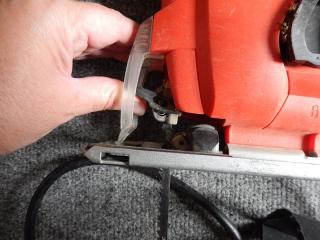 There are two types of standard blades for jigsaws. The "U" style was common in the past, but has been slowly giving way to the "T" shank style. The reason for this is a swing towards Quick-Change or Quick-Release blade holders. In the past, the blade would need to be inserted and a nut tightened to hold the blade firmly in place, making blade changing a time consuming delay in a project. With the change to the "T" shank, a spring loaded lever can be pushed to release the blade and the new blade stuck right into place. While some "U" blades are used with a quick-change, and some saws can use either type blade, I prefer the added security that the "T" gives to the blades in a quick-change saw. There are two types of standard blades for jigsaws. The "U" style was common in the past, but has been slowly giving way to the "T" shank style. The reason for this is a swing towards Quick-Change or Quick-Release blade holders. In the past, the blade would need to be inserted and a nut tightened to hold the blade firmly in place, making blade changing a time consuming delay in a project. With the change to the "T" shank, a spring loaded lever can be pushed to release the blade and the new blade stuck right into place. While some "U" blades are used with a quick-change, and some saws can use either type blade, I prefer the added security that the "T" gives to the blades in a quick-change saw.As for the quick-change vs not... I would never even bother looking at a jigsaw that doesn't have a quick-change blade release. Not only does it save a lot of time when you need to change blades, it also encourages you to use the correct blade or a new blade when needed because it is so easy to change out. Blade Storage... Blade storage is a bit difficult to quantify. Most jigsaws have some form of on-board blade storage, but how much it would mean to you and how much you used it is probably one of the more personal choice features of a saw. For me, I like the handiness of having a few blades on the saw... usually metal, fast-wood, and clean-wood. However, I have also discovered that having those blades extra-handy means that I am often using dull blades, or not the perfect blade for the material I am cutting. If you can get used to it, I think it would be better to keep your full selection of jigsaw blades close to the tool and readily available for change-outs. A couple years ago, I would have said that corded is the only way to get enough power to a saw. However, since then I have discovered the joys of better quality tools and lithium power. And while I consider a drill (or two) to be a must in the cordless variety, I am still getting used to the freedom of a cordless jigsaw. Quick, fun, easy... yes, yes, yes. Necessary? Maybe not. There are three things to consider when deciding if a cordless jigsaw is the way to go. First, how much will you use the saw?... then double that. Because really, a jigsaw is so versatile that you will use it much more than you think. If you will only be using it vary rarely, then corded can be a cheap alternative and not too much trouble to drag out the extension cord for when needed. Second, where will you be using the saw the most? If it is in a workshop where you don't have to put the saw and cords away, you may not need a cordless. However, if you will be using the jigsaw a lot, or don't have a proper workshop for it to live in, you may want to consider cordless. And the third and biggest thing to consider is that cheap cordless saws generally don't have enough power to be reasonable substitutes for corded. Several years ago I purchased a very cheap set of cordless tools because it included a jig saw, but the poor quality and ni-cad batteries could not even cut through two shelf boards before the battery died. On the other hand, my mid-quality Ryobi One+ with a lithium battery was able to easily cut through several sections of hardwood without any sign of strain. However, the jigsaw is probably one of the tools that you never want to run out of power for, so if you don't have several batteries to swap out, you may still want to look at a corded version. This being the case, I would really recommend the light hobby-user to get a corded jigsaw unless you already have (or plan on getting) a higher quality set of cordless tools with several batteries that the jigsaw can use. Conclusions and Buying Tips... If you don't have one... get one. The versatility of a jigsaw make this a great first saw, and one that you will come back to time-and-again even if you have a whole collection of power saws. Low cost may easily take care of very light hobby work, but feel the materials... especially the "shoe". If this is the only saw you own, investing a little in it for stronger materials will mean it will last a lot longer through the abuse of being used for more difficult tasks. And... let's face it... if you are anything like me, you will be using it for something it wasn't intended for at some point. Having a little extra strength and quality could prevent having to buy a new one a couple years down the road. Variable speed and quick-change blades are a must, and go for the big pack of blades. Having blades for multiple materials and several of each type will keep you project moving and reduce wear-and-tear on the saw and you. The Blue model is not the most recent of the Ryobi One+ jigsaws, but it was still available in stores at least a few months ago when I got it for Christmas.  The first thing I noticed when I took it out of the packaging was how much stronger the "shoe" was compared to my ultra-cheapie types that I had purchased (and bent out of shape) in the past. Also, the grip is rubberized and nicer feeling than what I was used to. The first thing I noticed when I took it out of the packaging was how much stronger the "shoe" was compared to my ultra-cheapie types that I had purchased (and bent out of shape) in the past. Also, the grip is rubberized and nicer feeling than what I was used to. 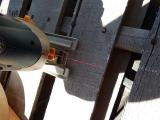 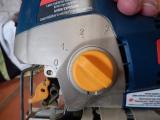 The laser line included in this model is also a nice feature that (when aligned properly) can really make straight cutting easier. Also an interesting feature is the cut speed (oscillating) selector. While a new user may not notice the difference in power and precision vs speed, I did notice a small difference and liked it. The laser line included in this model is also a nice feature that (when aligned properly) can really make straight cutting easier. Also an interesting feature is the cut speed (oscillating) selector. While a new user may not notice the difference in power and precision vs speed, I did notice a small difference and liked it.The grip is large for my tiny hands though, and it is taking me a little time to get used to pressing the safety lock with the very tip of my thumb when starting a cut. The saw itself performed quite well in several cuts, and did a great job with a thin scroll-style blade when cutting a smooth curve. There are two cons to this model that I see however. First is the large hand grip and somewhat awkward placement of the safety button. And the second is the blade storage. It is not smooth inside, so it makes getting blades in and out somewhat difficult. Also, it doesn't fit long blades, the closing flap does not stay tight and would pop open at the slightest bump, and it doesn't fit the hex tools needed for adjusting the shoe. I would rather get rid of the blade storage all-together and put the hex tools in holders there. This is actually not a very big deal though, as most on-board storage for blades on jigsaws is poor at best. However, it could definitely use some more thought as it appears much like someone though "Oh... yea... we forgot some blade storage...... er... lets just put a cap on that area and call it done." I am more disappointed in the fact that the hex-tools for adjusting are not on-board. 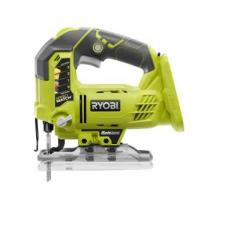 While the safety button placement appears to be fixed in the newer green model P523, it is not clear if the blade storage or on-board tools have been addressed. A couple features that I think have improved is the visual clarification on the 0-3 cut speed settings right on the saw, and the "Blade Saver" feature that extends the shoe to use fresh areas of the blade. While the safety button placement appears to be fixed in the newer green model P523, it is not clear if the blade storage or on-board tools have been addressed. A couple features that I think have improved is the visual clarification on the 0-3 cut speed settings right on the saw, and the "Blade Saver" feature that extends the shoe to use fresh areas of the blade.Of possibly even greater interest is the "Powerful sight line blower clears debris for more accurate cutting". That could be a real boon as I am constantly blowing the sawdust away from my cutting line and breathing a lot of sawdust in the process.
| |
|
POST LINKS BACK TO: 6/3/2014 8:26:39 PM - Tool Review: Drills, A Tale Of Four Drills, and The Ryobi One+ Compact Drill | |
Next Post - Previous Post List View | |
| COMMENTS | |
| 6/30/2014 9:57:29 AM Punkin | |
| 6/30/2014 11:16:10 AM TinkerT Thanks. If I can help even one person get a tool that they have fun with, it is all worth it. |
Add Your Comment...


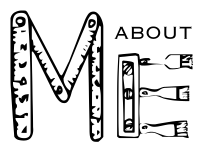


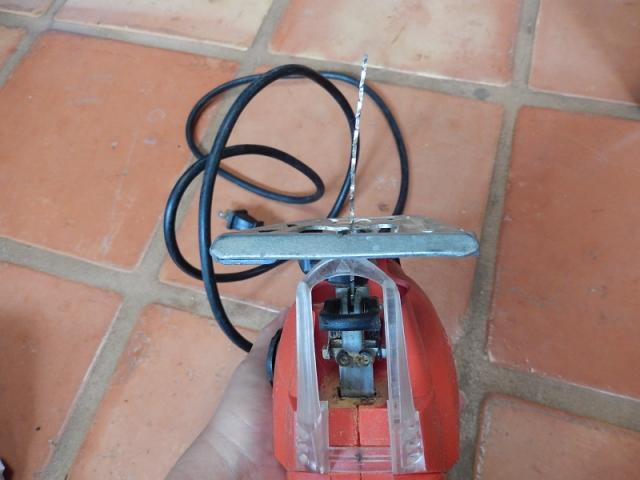
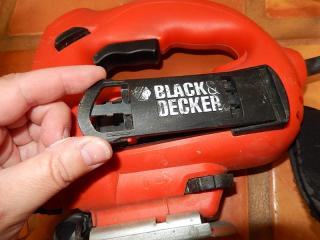
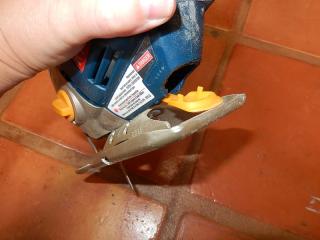

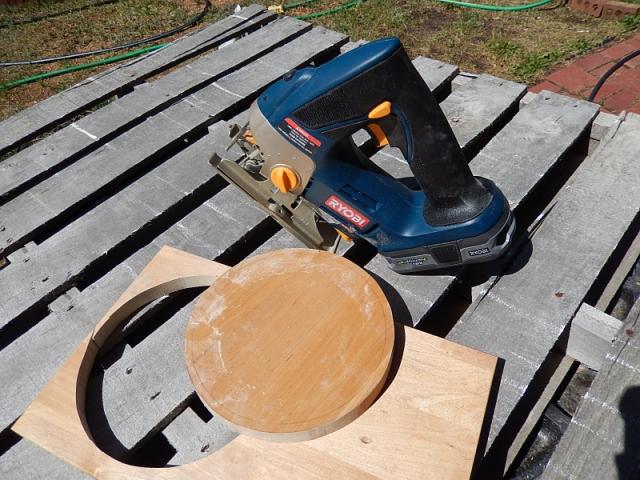
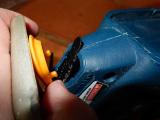
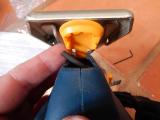

I have often thought of getting one for me. Your information has been very helpful to know the right tool to purchase.
I have learned much by what you have written and hope others will profit from it also.